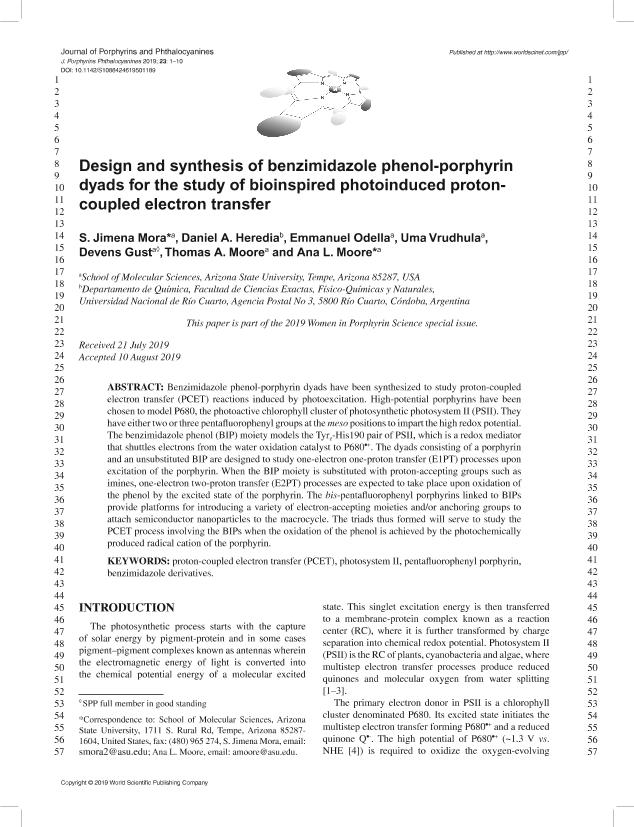Artículo
Design and synthesis of benzimidazole phenol-porphyrin dyads for the study of bioinspired photoinduced proton-coupled electron transfer
Mora, Sabrina Jimena ; Heredia, Daniel Alejandro
; Heredia, Daniel Alejandro ; Odella, Emmanuel
; Odella, Emmanuel ; Vrudhula, Uma; Gust, Devens; Moore, Thomas A.; Moore, Ana L.
; Vrudhula, Uma; Gust, Devens; Moore, Thomas A.; Moore, Ana L.
 ; Heredia, Daniel Alejandro
; Heredia, Daniel Alejandro ; Odella, Emmanuel
; Odella, Emmanuel ; Vrudhula, Uma; Gust, Devens; Moore, Thomas A.; Moore, Ana L.
; Vrudhula, Uma; Gust, Devens; Moore, Thomas A.; Moore, Ana L.
Fecha de publicación:
09/2019
Editorial:
World Sci Publ Co Inc
Revista:
Journal Of Porphyrins And Phthalocyanines
ISSN:
1088-4246
e-ISSN:
1099-1409
Idioma:
Inglés
Tipo de recurso:
Artículo publicado
Clasificación temática:
Resumen
Benzimidazole phenol-porphyrin dyads have been synthesized to study proton-coupled electron transfer (PCET) reactions induced by photoexcitation. High-potential porphyrins have been chosen to model P680, the photoactive chlorophyll cluster of photosynthetic photosystem II (PSII). They have either two or three pentafluorophenyl groups at the meso positions to impart the high redox potential. The benzimidazole phenol (BIP) moiety models the Tyrz-His190 pair of PSII, which is a redox mediator that shuttles electrons from the water oxidation catalyst to P680•+. The dyads consisting of a porphyrin and an unsubstituted BIP are designed to study one-electron one-proton transfer (E1PT) processes upon excitation of the porphyrin. When the BIP moiety is substituted with proton-accepting groups such as imines, one-electron two-proton transfer (E2PT) processes are expected to take place upon oxidation of the phenol by the excited state of the porphyrin. The bis-pentafluorophenyl porphyrins linked to BIPs provide platforms for introducing a variety of electron-accepting moieties and/or anchoring groups to attach semiconductor nanoparticles to the macrocycle. The triads thus formed will serve to study the PCET process involving the BIPs when the oxidation of the phenol is achieved by the photochemically produced radical cation of the porphyrin.
Archivos asociados
Licencia
Identificadores
Colecciones
Articulos(CCT - CORDOBA)
Articulos de CTRO.CIENTIFICO TECNOL.CONICET - CORDOBA
Articulos de CTRO.CIENTIFICO TECNOL.CONICET - CORDOBA
Citación
Mora, Sabrina Jimena; Heredia, Daniel Alejandro; Odella, Emmanuel; Vrudhula, Uma; Gust, Devens; et al.; Design and synthesis of benzimidazole phenol-porphyrin dyads for the study of bioinspired photoinduced proton-coupled electron transfer; World Sci Publ Co Inc; Journal Of Porphyrins And Phthalocyanines; 23; 11-12; 9-2019; 1336-1345
Compartir
Altmétricas



